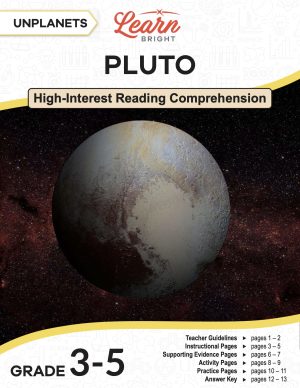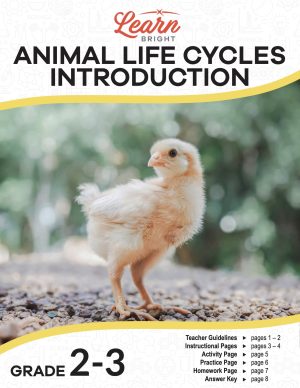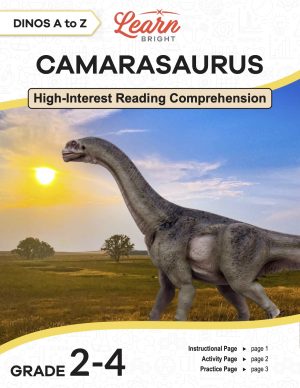Description
What our Cells STEM lesson plan includes
Lesson Objectives and Overview: Cells STEM is an hands-on lesson that further details the differences between plant and animal cells. Students will discover which organelles exist in both plant and animal cells and which exist in just one or the other. They will also learn the functions of these cell parts and construct models of both types of cell to compare. This lesson is for students in 3rd grade and 4th grade.
Classroom Procedure
Every lesson plan provides you with a classroom procedure page that outlines a step-by-step guide to follow. You do not have to follow the guide exactly. The guide helps you organize the lesson and details when to hand out worksheets. It also lists information in the yellow box that you might find useful. You will find the lesson objectives, state standards, and number of class sessions the lesson should take to complete in this area. In addition, it describes the supplies you will need as well as what and how you need to prepare beforehand. For this lesson, you will need writing utensils and Legos or other connecting blocks for the lesson opening. For the activity portion, you need poster boards, markers, construction paper, boxes (optional), and clay (optional). The practice worksheet also requires small tokens or ink blotters, and the homework assignment requires paper plates and colored pencils or markers.
Options for Lesson
In the “Options for Lesson” section of the classroom procedure page, you will see a couple suggestions for additional activities or ideas to add to the lesson if you want to. One idea is to consider putting the “cell city” on display for the school to see once students complete it during the activity. Another option, if possible, is to show students a video of the cell parts to see what they look like under a microscope.
Teacher Notes
The teacher notes page provides an extra paragraph of information to help guide the lesson. It explains that each activity is meant to help students understand how cells are the building blocks of all life. You can use the blank lines to write down any other ideas or thoughts you have about the topic as you prepare.
CELLS STEM LESSON PLAN CONTENT PAGES
What Is a Cell?
The Cells STEM lesson plan contains two content pages. To start off, the lesson describes a cell as the basic unit of life. The word cell comes from a Latin word meaning small compartment. While some organisms consist of a single cell (such as bacteria), others are made up of trillions of cells (such as humans). But not all cells are exactly the same.
Plant and animal cells, for instance, are not the same. Different types of cells do different jobs. Each cell consists of various parts that have special functions. These parts are also known as organelles. Students will discover that knowing what function each organelle performs is essential.
Parts of Cells
The lesson then lists the organelles that exist in either plant or animals cells or both. The first part is the plasma membrane, which is on the outside of a cell. It is like a flexible wall that keeps all of the other cell parts inside. It also determines what can enter the cell and what cannot. Students could compare this to a castle wall and its guards.
Cytoplasm is the next part. This organelle is more like the substance that all other parts float around in within the cell. The nucleus is next, and this is the part that runs the cell, kind of like the brain. Within the nucleus is the nucleolus, which produces proteins called ribosomes.
Next on the list is endoplasmic reticulum, which is a collect of tubes. Inside the tubes, it packages and transports proteins and fats. It works with the ribosomes, the Golgi body, and the nucleus to help ensure that the cell functions properly. Speaking of the Golgi body, this cell part collects all the simple molecules and puts them together to make more complex molecules. It then packages those complex molecules and either stores them or sends them out of the cell. The Golgi body also builds lysosomes.
Mitochondria are the powerhouses of the cell. They make energy so that the cell can operate. Vacuoles are storage areas that store nutrients for the cell. Lysosomes, which the Golgi body builds, help rid the cell of any waste. They break down things and work a lot like our body’s digestive system.
Plant Cells v. Animal Cells
The lesson then lists a few parts that only exist in either a plant cell or an animal cell. First up is the cell wall. Only plant cells contain a rigid cell wall, just outside the plasma membrane, that causes the cell to look rectangular. It also helps plants stand upright without bones.
Another part only plant cells have is chloroplast. Chloroplasts convert water and sunlight into energy through the process of photosynthesis. One more plant-cell-only organelle is the vacuole. A plant cell has only one large vacuole that stores water and sap. It will grow or shrink depending on how much water the plant stores. When a plant lacks water, the vacuole shrinks, causing the plant to droop.
Animal cells have a few unique parts as well. There are protrusions on the outside of the cells that help them move. Some of these are cilia, which look like tiny hairs, and they propel the cell along by moving. The other is a flagellum, a single long projection that whips itself around to move the cell forward. A cell cannot have both cilia and a flagellum, however. It can only have one or the other.
Key Terms
Here is a list of the vocabulary words students will learn in this lesson plan:
- Cell—the “small compartment” or building block that makes up all living things
- Organelle—the name for a part of a cell
- Plasma membrane—a flexible wall outside a cell that keeps all organelles inside and determines what substances can enter the cell
- Cytoplasm—the substance that all the other organelles float around in within a cell
- Nucleus—the organelle that runs the cell
- Nucleolus—a part of the nucleus that creates proteins called ribosomes
- Endoplasmic reticulum—a collection of tubes that package and transport proteins and fat
- Golgi body—an organelle that collects simple molecules and converts them to more complex molecules; packages complex molecules and either stores them or sends them out of the cell; also build lysosomes
- Mitochondria—the “powerhouses” of the cell that make energy so the cell can operate
- Vacuole–the storage area for cells that store nutrients
- Lysosomes—the organelle responsible for ridding the cell of waste and breaking things down
- Cell wall—a plant cell part that gives plants their structure and ability to stand upright
- Chloroplasts—the plant cell parts that convert water and sunlight into energy through photosynthesis
- Cilia—animal cell parts that look like tiny hairs that propel a cell along by moving all together
- Flagellum—an animal cell part that looks like a single long projection that whips itself around to move the cell forward
CELLS STEM LESSON PLAN WORKSHEETS
The Cells STEM lesson plan includes three worksheets: an activity worksheet, a practice worksheet, and a homework assignment. Each one will help students solidify their grasp of the material they learned throughout the lesson. You can refer to the classroom procedure guidelines to know when to hand out each worksheet.
CITY BUILDINGS ACTIVITY WORKSHEET
Students will work in groups for the activity. They will first decide whether to make a model of an animal cell or a plant cell. Then they will use the table on the worksheet to list the various cell parts and the city building they would represent. The third column is for students to explain how the cell part and the building they chose are similar. For instance, the nucleus is like a City Hall building because they control the actions of the cell or city respectively.
BINGO PRACTICE WORKSHEET
For the practice worksheet, students will fill in a Bingo card using the 16 boldfaced vocabulary words throughout the content pages. You will make multiple cards by placing the terms in different squares on each page. Cut out the words from the Vocabulary Page, and choose a student to call them out as they pick them. For advanced players, you could call out the definitions rather than the actual terms.
CELLS STEM MODEL HOMEWORK ASSIGNMENT
The homework assignment requires students to create a model of a cell. They will draw all of the organelles of an animal cell specifically. The chart on the worksheet page lists the cell parts they will use. Students must fill in the right column with the color they will use for each organelle.
Worksheet Answer Keys
There are answer keys for the three worksheets in the lesson plan PDF. Given the nature of these assignments, students responses will vary. However, the activity and practice answer keys provide sample responses for reference. If you choose to administer the lesson pages to your students via PDF, you will need to save a new file that omits these pages. Otherwise, you can simply print out the applicable pages and keep these as reference for yourself when grading assignments.









